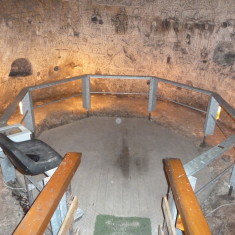Royston Cave
Royston's best kept secret
By James Robinson
I’d like to give you some information about Royston Cave but first of all I’d like to tell you how I became Cave manager.
It all started over 40 years ago with my mother’s fascination with horror stories. She loved a series of pulp paperbacks called ‘Supernatural Stories’ which were published in the 1950s and 1960s. There were 109 of them and she wanted to collect them all.
An author called Lionel Fanthorpe wrote most of these either under his real name or under assumed names (which were always anagrams of his real name). Over time, she managed to get most of them but by the 1990s there were a few she just couldn’t get so I tried to help.
I wrote to Lionel Fanthorpe to see if he could help but when he found out I was from Royston he asked if I could arrange a visit for him to the Cave. I then got in contact with Peter Houldcroft the previous Cave manager and arranged the visit for Lionel.
My interest grew from then onwards and Peter persuaded me to get involved and now I manage the Cave and spend most of my spare time doing one thing or another to do with it.
Anyway, here is a very short explanation of the mystery behind Royston cave.
Royston Cave
Royston Cave is unique in Europe for the quantity and extent of its chalk carvings. It is also a place of mystery as no one really knows who made the Cave or why.
The Cave is a man-made cavern in the shape of a beehive, with a small aperture at the top for ventilation. Its most remarkable feature is an extensive range of wall carvings representing the Crucifixion, the Holy Family and several saints, among them St Katherine, St Laurence and St Christopher. Other carvings are less easily identified and some have been interpreted as possible pagan symbols.
The carvings are medieval in appearance and some studies of the Cave have drawn comparisons from the wall carvings and other sources to indicate that it may have been used by the Knights Templar. Other studies point to the existence of Masonic symbols within the Cave whilst other studies indicate that the Cave may simply have been a hermitage or a prison.
Whatever the case, there is no historical evidence to support the theories as, prior to 1742, when the Cave was rediscovered, no records exist to throw any light on its use or even to show that it existed at all. Also, there is no organic material that could be used to date the Cave so the mystery persists.
We may never know for sure who made the carvings but new theories appear regularly which all adds to the debate and, in my opinion, just makes it even more fascinating.
Royston Cave








Add your comment about this page
My dad, Chris Tew, used to be a curator of Roston Cave in the 70s/80s. I used to go down there with him on a Saturday morning. This was before the railings were installed. I enjoyed listening to the talk he gave to visitors.